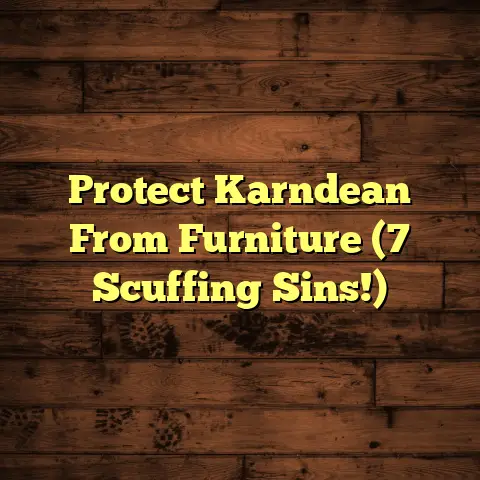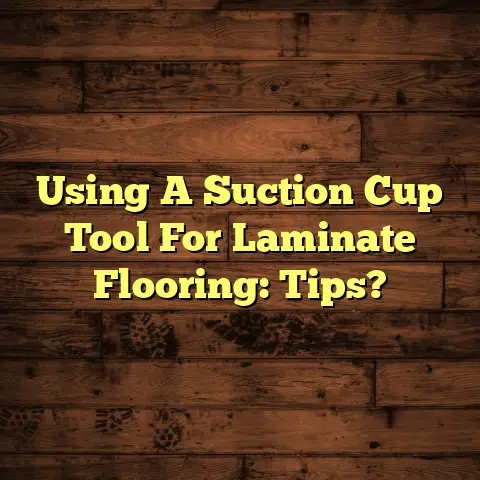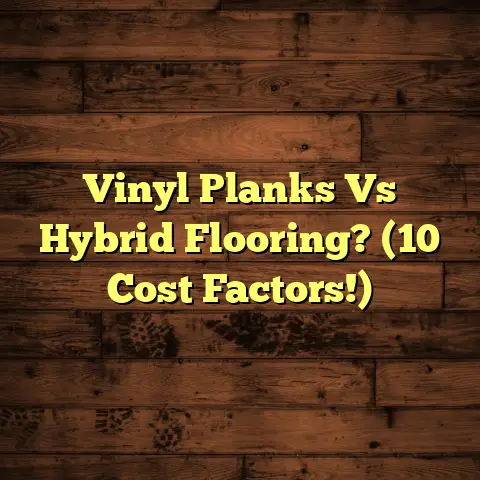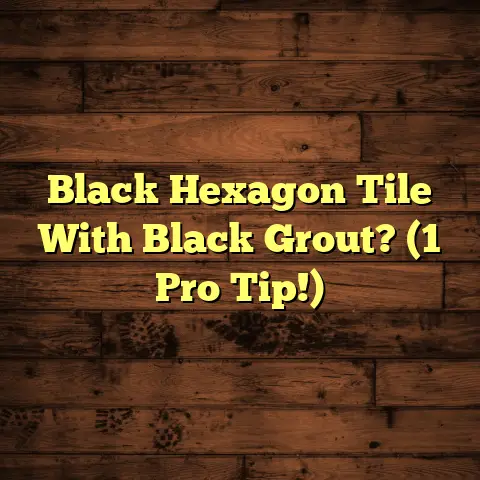Safe Rug Pads for Laminate Floors? (3 to Avoid!)
Ever walked into a beautifully decorated home and thought, “Wow, those laminate floors look amazing!”?
I know I have.
Laminate flooring has become a staple in
modern homes, and for good reason.
It’s durable, stylish, and often more budget-friendly
than hardwood.
But here’s the thing: pairing it with the
wrong rug pad can turn your dream floor into a nightmare.
Let’s dive into the world of rug pads and laminate floors, and I’ll share some hard-earned wisdom (and a few horror stories) from my years in the business.
The Dilemma of Choosing Rug Pads for Laminate Flooring
Picture this: You’ve just installed gorgeous laminate
flooring in your living room.
You find the perfect area rug
to tie the room together, adding warmth and personality.
But wait! What about a rug pad?
It’s not just about preventing slips and falls (although
that’s a big part of it!).
Rug pads add cushioning, extend
the life of your rugs, and protect your precious floors.
But here’s the catch: not all rug pads are created equal.
The wrong choice can lead to scratches, discoloration, or
even warping of your laminate.
Trust me, I’ve seen it all.
With so many options out there, how do you choose the
right one?
That’s what we’re here to figure out!
I’m going to walk you through what makes a rug pad safe for laminate floors, and, more importantly, I’ll tell you about three types you should avoid like the plague.
Section 1: Understanding Laminate Flooring
So, what exactly is laminate flooring?
Simply put, it’s a multi-layer synthetic flooring product fused together through a lamination process.
Typically, you’ve got:
-
A wear layer: This is the top layer that protects against scratches, stains, and fading.
-
A decorative layer: This is a high-resolution photographic image that mimics wood, stone, or tile.
-
A core board: Usually made of high-density fiberboard (HDF) or medium-density fiberboard (MDF), this provides stability and impact resistance.
-
A backing layer: This bottom layer provides moisture resistance and helps prevent warping.
The Rise of Laminate
Laminate has become incredibly popular, and it’s easy to
see why.
According to Statista, the global laminate flooring
market was valued at over $40 billion in 2023.
That’s a lot of floors!
Laminate offers a sweet spot of affordability, durability,
and style.
You can get the look of hardwood without the
hefty price tag or the fuss of real wood maintenance.
The Good and the Not-So-Good
Benefits:
-
Cost-effective: Generally cheaper than hardwood, tile, or stone.
-
Durable: Resistant to scratches, dents, and fading.
-
Easy to install: Many laminate floors come with click-lock systems, making DIY installation a breeze.
-
Low maintenance: Easy to clean and requires no special treatments.
Drawbacks:
-
Moisture sensitivity: While the backing layer provides some protection, excessive moisture can cause warping and swelling.
-
Not repairable: Unlike hardwood, you can’t sand down and refinish laminate.
-
Can feel cold: Laminate doesn’t retain heat as well as other flooring options.
-
Slippery surface: This is where rug pads come in handy!
Keeping it Pristine
Maintaining the integrity of your laminate is crucial.
Regular cleaning, avoiding excessive moisture, and using the
right cleaning products can go a long way.
But remember, protecting your laminate also means choosing the right rug pad!
Section 2: The Role of Rug Pads
Okay, let’s talk rug pads. What are they, and why should you care?
A rug pad is a material placed between your rug and your
floor.
Think of it as a protective barrier and a comfort
enhancer all in one.
More Than Just a Cushion
Rug pads do a lot more than just make your rug feel softer
underfoot.
Here’s a rundown of their primary functions:
Safety: Prevents rugs from slipping and sliding, reducing the risk of falls.
According to the National Floor Safety Institute, falls are a leading cause of injury in the US.
Rug pads can significantly reduce that risk.-
Comfort: Adds cushioning and support, making your rug more comfortable to walk on.
-
Longevity: Protects your rug from wear and tear by reducing friction against the floor.
-
Floor protection: Prevents scratches, dents, and stains on your flooring.
-
Noise reduction: Absorbs sound, making your home quieter.
-
Air circulation: Some rug pads allow for better airflow, preventing moisture buildup and mold growth.
The Compatibility Factor
Not all rug pads are created equal, and not all are suitable for every type of flooring.
The key is to choose a rug pad that’s compatible with your specific flooring material.
What works wonders on hardwood might spell disaster for
laminate.
That’s why it’s essential to do your research
and choose wisely.
Section 3: Why Choosing the Right Rug Pad Matters
for Laminate Floors
Laminate flooring, while durable, has its vulnerabilities.
It’s a smooth surface, which means rugs can easily slip and
slide.
And while the wear layer protects against scratches,
certain rug pad materials can actually cause damage over
time.
The Slippery Slope
One of the biggest challenges with laminate is its slippery
surface.
This is where rug pads come in, providing much-needed
grip and preventing accidents.
But here’s the thing: some rug pads can actually increase the risk of slipping if they don’t have adequate grip on both the rug and the floor.
The Damage Factor
Certain rug pad materials can react with the laminate flooring’s finish, causing discoloration, staining, or even damage to the wear layer.
I’ve seen cases where the chemicals in the rug pad break down the laminate’s protective coating, leaving it vulnerable to scratches and fading.
Real-Life Horror Stories
Let me share a quick story.
I once had a client who used a
cheap PVC foam rug pad under her area rug.
After a few months,
she noticed a strange discoloration on her laminate floor
where the rug pad had been.
Turns out, the PVC had reacted with the laminate, causing a
permanent stain.
She had to replace a section of her flooring,
all because of a bad rug pad choice!
Another client used a rubber-backed rug pad, thinking it
would provide the best grip.
Instead, the rubber bonded to
the laminate, and when she tried to remove the rug, it peeled
off the top layer of her flooring!
These stories aren’t just cautionary tales; they’re real examples of what can happen when you don’t choose the right rug pad for your laminate floors.
Section 4: The Three Rug Pads to Avoid
Alright, let’s get down to the nitty-gritty.
Here are three
types of rug pads that I strongly advise against using on
laminate floors:
1. PVC Foam Pads
What are they?
PVC (polyvinyl chloride) foam pads are those cheap, waffle- or grid-patterned rug pads you often find at big-box stores.
They’re made from a synthetic plastic polymer and are known for their affordability.
The Chemical Conundrum
The problem with PVC foam pads is their chemical composition.
PVC can release harmful chemicals over time, especially when
exposed to heat or sunlight.
These chemicals can react with the laminate flooring’s finish, causing discoloration, staining, and even degradation of the wear layer.
When Things Go Wrong
I’ve seen countless cases where PVC foam pads have caused
damage to laminate floors.
The most common issue is discoloration,
where the rug pad leaves a yellowish or brownish stain on the
flooring.
In more severe cases, the PVC can actually break down the laminate’s protective coating, making it more susceptible to scratches and fading.
2. Rubber Backed Pads
The Rubber Deception
Rubber-backed rug pads seem like a good idea in theory.
They’re designed to provide superior grip and prevent rugs
from slipping.
However, the type of rubber used in these pads can be problematic for laminate floors.
The Bonding Issue
The issue with rubber-backed pads is that they can create a
chemical bond with the laminate surface over time.
This is
especially true with certain types of synthetic rubber.
When you try to remove the rug, the rubber can actually peel off the top layer of the laminate, causing irreparable damage.
Case Studies in Catastrophe
I had a client who used a rubber-backed rug pad under her
dining room rug for several years.
When she finally decided
to replace the rug, she discovered that the rubber had fused
to the laminate.
Trying to remove the rug pad resulted in large chunks of the laminate’s wear layer peeling off, leaving her with a costly repair bill.
3. Felt Pads
The Felt Fallacy
Felt pads are often touted as a safe and natural option for
rug pads.
They’re made from compressed fibers, typically wool
or synthetic materials, and are known for their cushioning
properties.
The Moisture Trap
The problem with felt pads is that they can retain moisture.
If you spill something on your rug, or if there’s excessive
humidity in your home, the felt pad can absorb that moisture
and trap it against the laminate floor.
This can lead to mold growth, which can damage both your rug and your flooring.
A Word of Caution
I’ve heard horror stories from other flooring professionals about felt pads causing significant damage to laminate floors.
The trapped moisture can cause the laminate to swell and warp, leading to costly repairs or even complete floor replacement.
Section 5: Safe Alternatives to Consider
Okay, so we’ve covered the rug pads to avoid.
Now, let’s
talk about some safer alternatives for your laminate floors.
I’m not going to give you specific brand recommendations here, but I’ll point you in the right direction.
The Key is Breathability
When choosing a rug pad for laminate floors, look for materials that are breathable and non-toxic.
This means avoiding materials that can trap moisture or release harmful chemicals.
Options to Explore
Here are a few safe rug pad options to consider:
-
Natural rubber pads: These are made from natural rubber, which is less likely to react with laminate flooring than synthetic rubber.
-
Felt and rubber combination pads: These pads combine a thin layer of felt with a natural rubber backing, providing cushioning and grip without trapping excessive moisture.
-
Memory foam pads: These pads offer excellent cushioning and are generally safe for laminate floors, as long as they’re made from non-toxic materials.
Designed for Laminate
Look for rug pads that are specifically designed for use on
laminate flooring.
These pads are typically made from materials
that won’t damage the finish or trap moisture.
Section 6: Conclusion
Choosing the right rug pad for your laminate floors is crucial for maintaining their beauty and longevity.
By avoiding PVC foam pads, rubber-backed pads, and felt pads, you can protect your floors from scratches, discoloration, and moisture damage.
Take the time to research your options and choose a rug pad that’s specifically designed for laminate flooring.
Your floors (and your wallet) will thank you!
Remember, a little bit of research can save you a whole lot of headache (and money) down the road.
Happy flooring!





